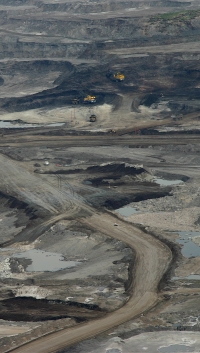|
Syncrude’s Mildred Lake operations (seen here from the north) spread west from the Athabasca River about 40 km north of Fort McMurray. |
Oil sands are found in several places around the world. Canada and Venezuela have the largest of these petroleum deposits, and Alberta’s oil sands are the most developed.1
Source: Richard F. Meyer, Emil D. Attanasi and Philip A. Freeman, “Map of Sedimentary Provinces Reporting Natural Bitumen,” plate 3 from Heavy Oil and Natural Bitumen Resources in Geological Basins of the World, U.S. Geological Survey, 2007.
Oil sand is a naturally occurring mixture of sand or clay, water and tar-like bitumen.
- In an oil sand deposit, each grain of sand is covered by a thin layer of water and then by a layer of the highly viscous bitumen.2
- Bitumen is a heavy form of crude oil. Like Alberta’s conventional crude oil, the bitumen probably formed millions of years ago from the remains of tiny sea creatures that lived in an ancient ocean that once covered Alberta. In the case of the oil sands, the petroleum moved upwards from where it formed and saturated large areas of sand closer to the surface. Bacteria then fed on the lighter petroleum chemicals in the oil, leaving behind only the molasses-like bitumen.3
- Unlike conventional crude oil, bitumen is too thick and viscous to flow naturally or to be pumped out of the ground unless it is heated or diluted with a solvent.4
- Before it can be refined like conventional crude oil, bitumen must be upgraded into synthetic crude oil.5
Oil sands and tar sands are the same thing.
- While technically called “bituminous sands,” Alberta’s deposits were originally called “tar sands” because of their thick, sticky properties.
- The term “oil sands” gained popularity in the mid-1990s after government and industry efforts to improve public perception of the dirty-sounding tar sands.6
Dig deeper into the oil sands:
- 1. Alberta Energy, “What is Oil Sands,” revised June 11, 2009.
- 2. Energy Resources Conservation Board, “Oil Sands” (accessed May 14, 2009).
- 3. Energy Resources Conservation Board, “Oil Sands” (accessed May 14, 2009).
- 4. Alberta Energy, “What is Oil Sands,” revised June 11, 2009.
- 5. Alberta Energy, “What is Oil Sands,” revised June 11, 2009.
- 6. National Task Force on Oil Sands Strategy, The Oil Sands: A New Energy Vision for Canada (Edmonton: Alberta Chamber of Resources, 1995), 5.




